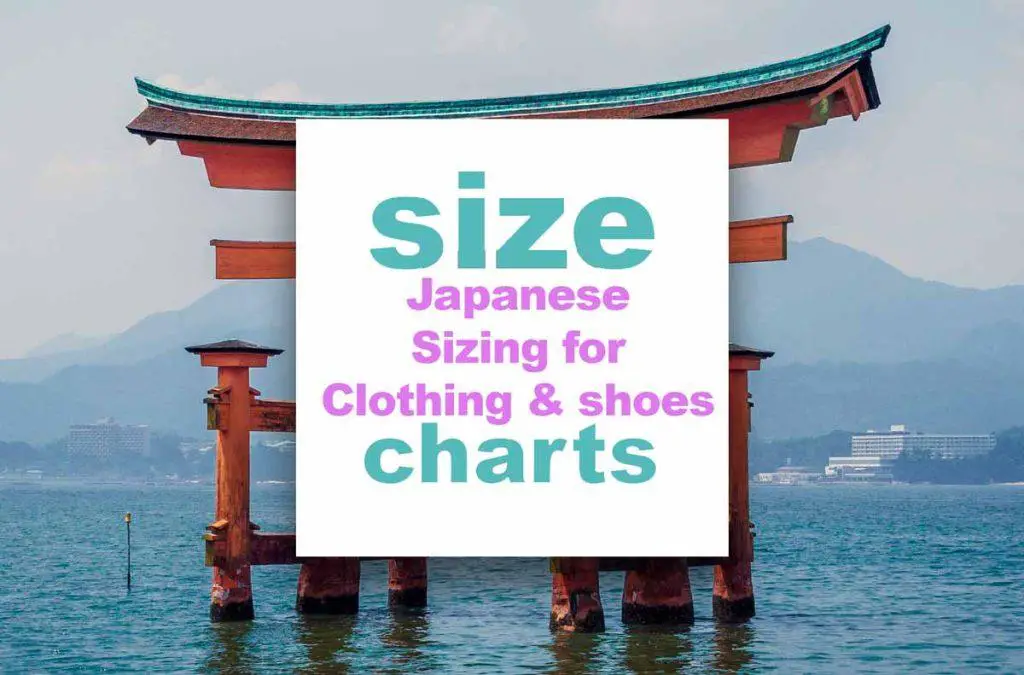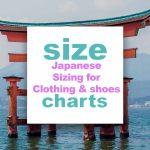Japan size charts – A full Guide to Japanese Apparel Sizing
Welcome to our comprehensive manual on Japan size charts for apparel and shoes. What is special about Japanese sizing? Japanese sizing relies on metric measurements, primarily centimeters (cm) for clothing and millimeters (mm) for shoes. Familiarize yourself with these units to accurately interpret and compare sizes.

At size-charts.com our objective is to assist you in comprehending the complexities of Japanese sizing, enabling you to make well-informed decisions and ensure a comfortable and tailored fit. Whether you’re planning a trip to Japan or are intrigued by Japanese fashion, this manual aims to provide you with intricate details and valuable insights into Japanese apparel sizes.
Transforming American and British clothing Sizes to Japanese Measurements. It’s as simple as starting with the number ’28’ in the US, which matches with ’60’ in Japan. Then, every time you go up one point in American or British sizes, just add 2.5 to the Japanese size. You’ll unlock the perfect fit and look super stylish wherever you go!
Japan Rabbit
Table of Content on Japan size charts
- Introduction
- Understanding Japanese Apparel Sizes
- Divergence in Sizing Systems
- Key Measurements and Size Conversion
- Women’s Apparel Sizes
- Tops and Dresses
- Bottoms
- Men’s Apparel Sizes
- Shirts and T-Shirts
- Pants and Shorts
- Children’s Apparel Sizes
- Age-Based Sizing
- Tips for Finding the Perfect Fit
- Measure Yourself
- Read Product Descriptions
- Check Customer Reviews
- Consider Stretch and Fit
- Conclusion
Related: Asian size to us size for clothes , Chinese size chart ,
Understanding Japanese Apparel Sizes
Divergence in Sizing Systems
Japanese apparel sizes deviate from the commonly used systems in other western countries, such as the United States or European sizes. While the latter typically rely on numerical or alphabetical sizing, Japan employs a unique system that relies on centimeter (cm) measurements.
Key Measurements and Size Conversion
To determine your Japanese apparel size, it is imperative to take precise body measurements. Here are the key measurements you should consider:
Bust/Chest size:
Measure the fullest part of your chest.
Waist size:
Measure the narrowest part of your waist. Hips: Measure the widest part of your hips. Once you have obtained these measurements, you can utilize our Japanese apparel size conversion chart to find the corresponding size. Our chart encompasses sizes for both women and men and general guidelines for children’s clothing.
Women’s Apparel Japan Size charts
| Japanese size | Bust (cm) | Waist (cm) | Hips (cm) |
| 3 (SS or XS) | 75 to 78 | 58 to 62 | 81 to 84 |
| 5 (S) | 78 to 81 | 62 to 66 | 85 to 88 |
| 7 (S) | 82 to 85 | 67 to 69 | 89 to 92 |
| 9 (M) | 86 to 88 | 70 to 72 | 92 to 96 |
| 11 (L) | 89 to 92 | 72 to 76 | 96 to 100 |
| 13 (LL or XL) | 92 to 96 | 77 to 80 | 100 to 104 |
| 15 (LLL or XXL) | 96 to 102 | 77 to 80 | 100 to 104 |
| 17 (4L or 3X) | 103 to 106 | 89 to 93 | 109 to 113 |
| 19 (5L or 4X) | 106 to 109 | 93 to 97 | 114 to 118 |
| 21 (6L or 4X) | 110 to 115 | 98 to 101 | 119 to 123 |
All Japanese dimensions are expressed in centimeters. Easily divide these numbers by 2.54 to get their equivalents in inches.
Tops and Dresses In Japan, women’s tops and dresses are commonly classified into three size groups: Small (S), Size Medium (M), and Large (L). However, it is crucial to note that these size categories may vary among different brands and designers. It is essential to refer to the specific measurements in the product description or size chart to select the appropriate size that complements your unique body shape.
Bottoms Japanese sizing for women’s bottoms, including skirts, pants, and jeans, follows a distinctive approach. Rather than relying solely on waist measurements, Japanese women sizing considers both waist and hip measurements. This ensures the correct size, a more customized fit, guaranteeing that the garment sits comfortably on your waist and hips.
Women’s Japan shoe size conversion charts
What is my shoes size 40 in Japan sizes?
JAPAN USA Europe 25.5cm 8 1/2 40
| Japan Shoe Size | Us Shoe Size | Uk Shoe Size | European Shoe Size | Alpha sizing |
| 21 | 4.5 | 2.5 | 35 | XXS/XS |
| 22 | 5.5 | 3.5 | 36 | XS/S |
| 23 | 6.5 | 4.5 | 37 | S |
| 24 | 7.5 | 5.5 | 38 | M |
| 25 | 8.5 | 6.5 | 39 | M/L |
| 26 | 9.5 | 7.5 | 40 | L |
| 27 | 10.5 | 8.5 | 41 | XL |
| 28 | 11.5 | 9.5 | 42 | XXL |
Size-charts.com Pro tip by Pablo: To convert sizes from centimeters to inches, divide by 2.54. Finding women’s shoes over 25 centimeters in Japan is challenging, although rare specialty shops may offer larger sizes. Remember that Japanese shoes are generally tighter than Western styles, especially if you already feel cramped in your Western boots.
Related: Socks have the same sizing standards as shoes.

Men’s Apparel Sizes
Shirts and T-Shirts
Regarding men’s shirts and t-shirts, Japanese sizing follows a system similar to women’s tops. The sizes are typically labeled as Small (S), Medium (M), Large (L), and Extra-Large (XL). However, similar to women’s clothing, it is essential to consider the brand’s specific measurements to ensure an accurate fit.
Pants and Shorts
Japanese sizing for men’s pants and shorts also incorporates waist and hip measurements, similar to women’s bottoms. This approach ensures that the clothing fits well around the waist and hips, providing comfort and style. With these size conversion tables, you’ll easily find out your Japanese Pant sizes
Men’s Japanese Shoe sizes
| Japan Size | US Size | UK Size | European Size | Alpha Sizes |
| 24 | 6 | 5.5 | 39 | S |
| 25 | 7 | 6.5 | 40 | M |
| 26 | 8 | 7.5 | 41 | L |
| 27 | 9 | 8.5 | 42 | XL |
| 28 | 10 | 9.5 | 43 | XXL |
| 29 | 11 | 10.5 | 44 | XXXL |
| 30 | 12 | 11.5 | 45 | XXXXL |
| 31 | 13 | 12.5 | 46 | XXXXXL |
Note: The table compares common Japanese men’s shoe sizes with corresponding sizes in the US, UK, European sizes, and alpha sizing systems. Please note that sizes may vary slightly between brands, and this information serves as a general reference.
Related: Philippines and Korean shoe size
Children’s Apparel Sizes
Age-Based Sizing
Children’s clothing sizes in Japan often adhere to an age-based system, covering sizes from newborns to early teens. However, it is crucial to note that the age range associated with each size can vary between brands. To ensure the best fit for your child, we recommend referring to the specific measurements provided by the brand or utilizing our comprehensive size chart.
Japanese clothing sizes explained (video)
Tips for Finding the Perfect Fit
Measure Yourself:
Take accurate body measurements and consult our Japanese apparel size conversion chart to find the best fit.
Read Product Descriptions:
Pay close attention to the measurements provided by the brand for each garment. This will assist you in choosing the right size based on your unique body shape. The product labels of major brands also convert Japanese sizing into international sizes
Check Customer Reviews:
Customer reviews can offer valuable insights into how a particular brand’s clothing fits. Reading reviews from customers with similar body types can help you make more informed decisions.
Consider Stretch and Fit:
Some Japanese clothing styles may have a more fitted or tailored design. If you prefer a looser fit, consider selecting a size larger than usual.
Frequently Asked Questions (FAQ)
How do Japanese clothing sizes differ from other countries?
Japanese sizes rely on centimeter measurements rather than numerical or alphabetical sizing used in other countries.
How can I convert my usual size to Japanese clothing size?
Use reliable size conversion charts specifically designed for Japanese sizes to find the corresponding measurement in centimeters.
What measurements should I consider for finding the right size in Japan?
Key measurements include bust/chest, waist, and hips for clothing sizes, and foot length for shoes.
How can I ensure a comfortable fit when buying Japanese clothing?
Pay attention to product descriptions, customer reviews, and consider the desired fit and style, such as loose or tailored.
Are Japanese clothing sizes different for men and women?
There are specific size categories for both men and women, and measurements may vary accordingly.
Where can I find reliable size information for Japanese children’s clothing?
Refer to brand-specific size charts or consult comprehensive size guides to ensure the best fit for your child. In the above size-charts, you find all info you need;
Conclusion
We trust that this comprehensive manual has shed light on the intricacies of Japanese apparel sizes and equipped you with the information to find the perfect fit. Remember to measure yourself accurately, refer to size charts, and carefully read product descriptions to make informed decisions. At Size-charts.com, we firmly believe that understanding the nuances of sizing is crucial to ensuring your comfort and satisfaction with Japanese fashion.
Picture in this post by Nicki Eliza Schinow on Unsplash
Related size charts
- Zara Women’s Size Chart – All Sizes for Clothes, Accessories and Shoes
- Bathrobe Size chart : How do I know my robe size ?
- Japan size charts – A full Guide to Japanese Apparel Sizing
- Shein Women’s Size Charts and Fitting Guide for Clothes & Shoes
- Farah Size Charts
- Firetrap Size Charts for Adults and Kids
- US Kids Clothes Size Chart : What are kids sizes in US – UK – EU ?
- Men’s Clothing Size Chart + Size Conversion
- Filling Pieces Size Charts
- Full Circle Size Charts
- Lularoe Size Chart and Fitting Guide
- Fred Perry Size Charts
- Asian Size to US Size Clothes
- French Connection Size Charts
- GANT Size Charts
- Axel Arigato Clothing Size Charts
- J jill Size Charts for Women
- Jumpsuit Size Chart for Adults and Kids
- Karl Lagerfeld Women Sizes
- Madewell Size Charts for Adults and Girls
- US Plus Size Chart for Men and Women





















